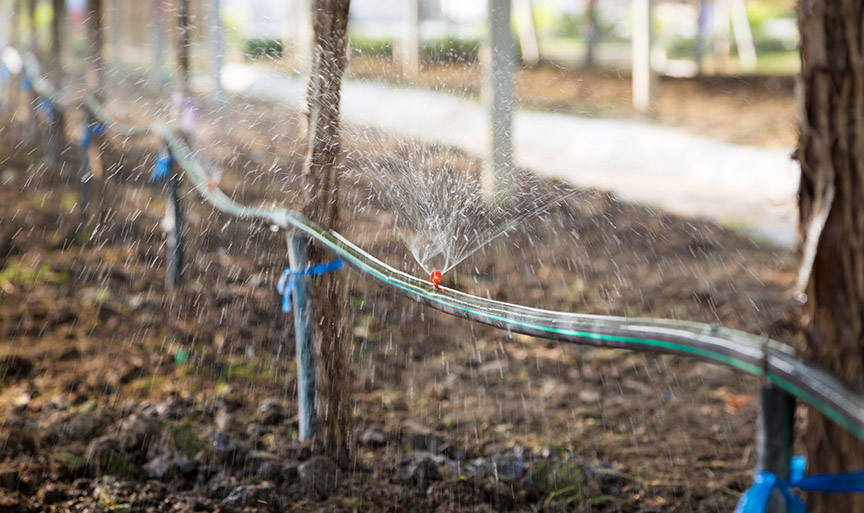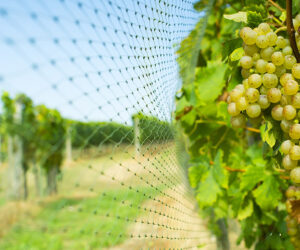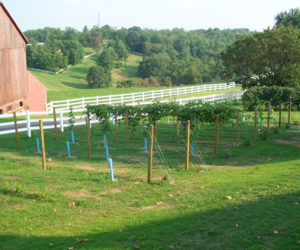
In the last 20-plus years writing this column for backyard vine warriors I’ve dedicated a lot of time and pages detailing the steps involved in planning, installing, planting, caring for, and nurturing young vines into production. We work together to make harvest successful, to know our pests, to understand canopy management, watering, even frost protection.
But now comes the payoff. Over the next three installments of “Backyard Vines,” I plan to focus in on the nuts and bolts of farming developed and mature wine grape vines in the major seasons of wine production: Summer, fall/winter, and finally, spring. The purpose of these articles will be to familiarize the readership with what needs to be done in the vineyard in the period of rapid growth and the initiation of fruit ripening, color change (veraison), and the vine changing from carbohydrate production for growth to sugar production for ripeness (and for the eventual production of delicious alcohol).
I have been known to say that wine grape farmers and winemakers are like surfers. We watch for signs of a change in nature, a wave, rain, hail, heatwaves, and we adjust our positions and equipment to gracefully ride the wave that nature gives us. Sometimes the wave is navigable, sometimes it’s a monster trying to rip us up on the reef. The more skill we have as farmers, the easier it will be to foresee problems on the horizon, adjust by experience and knowledge, and improve our growing techniques to mitigate the constant chaos nature inflicts upon our well-laid plans.
Through this article I’ll define and discuss the physiological needs of a vine, and the cycle of vine growth in the summer heat, and make a rough schedule of vineyard practices that will improve vine balance and wine quality.
Are we ready to learn? Good. School’s in for summer!
The Physiological Needs of a Vine in Summer
Sunshine
There are two important functions of sunlight in the production of high-quality wine grapes. One is quite obvious — sunlight (or more accurately PAR, or photosynthetically active radiation) is the fuel for a vine’s vegetative growth. Two weeks after budbreak, at the latest, the leaves are exporting carbohydrates for swift growth. Maximum growth in all grapevines occurs at 87 °F (31 °C).
The second importance of sunlight is almost the first in reverse. Once we have enough canopy to make sure we aren’t removing more than 10% of the leaves, we pull/pluck leaves from the fruiting zone to allow sunlight to fleck and penetrate the leaf canopy to touch the clusters and improve their flavor.
Sunlight on fruit (without burning it) is one of the take-home messages of this article. Dr. Richard Smart, who revolutionized canopy management in vineyards in the 1990s, suggests 10% of ambient sunlight flecking on the fruit (as the sun moves through the sky and dances on the clusters) is the minimum solar exposure to grapes to improve their flavor and wine quality.
To get geeky: Sunlight on clusters causes the green pepper/olive flavor (methoxypyrazine) in all grapes to be changed chemically into floral, spice, and high-toned fruit character (monoterpene). In short, fruit grown in the shade makes vegetal wine, while grapes grown in an open, sun-flecked canopy will show more floral character in white grapes and more high-toned fruit and spice character in reds.
A fruit zone that’s been opened by leaf-plucking has more advantages than just better wine. It also makes fungicide applications more efficient, as more material ends up inside the canopy or on the surface of the fruit. It also naturally reduces mold, mildew, rot, and pest pressure. All the things we hate in our vineyard prefer to grow and do their business in the shade — open up that canopy for all the right reasons, but be careful to not overexpose, as sunburn can ruin a crop too.
Leaf plucking should commence as soon as the vines have full canopy and the first flower is seen. This way, the vineyard will be leafed as flowering and fruit set finishes, and clusters will be exposed to gentle sun exposure just as they lose their caps and their berry flesh is exposed.
One last thing about sun: If temperatures exceed 100 °F (38 °C), the vines will likely shut down to protect themselves against withering, but on the bright side, all the fungal diseases are killed and the mildew/rot cycle is reset. Nature gives and takes. Sometimes in the same moment.
Wind
Wind can be our friend, but it can also frustrate our vines into shutting down. Let me explain.
First, wind in dormancy has no negative impact on the vine. So while the vine is woody, we don’t worry unless the temperatures get really, really cold.
Second, wind is our friend. Air movement dries out the fruit zone and our canopy, lowering the pressure of fungal diseases.
Third, wind can trigger problems or delays in the vineyard. At around 20–25 mph of wind in the vineyard, the vines shut down. They close their stomata/pores and cease photosynthesis, curtailing growth in spring and ripening in summer. In some regions, this extends hangtime and improves the flavor of the fruit, in other regions the winds can damage vines and snap shoots, or even canes.
Water
The most asked question of me, writing this column for the last few decades, is “How do I water my vineyard?” Let me tell you now, it’s a loaded question. I can’t give a number of gallons per week that will work for everyone, but I will give some specific guidance. It will be your responsibility to fine-tune it for your locale.

Water needs in the vineyard allow the vine to stay healthy, hydrated, and to exchange nutrients that help a vine grow, ripen, and even go to sleep and wake up. Vines like to go through budbreak with some water in the soil, and in a dry-farmed vineyard, a full soil profile that is saturated.
If you live in an area with very sandy soils and warm to hot summers, I would consider 5 gallons (19 L) a week per vine when the soil is dry and weather is warm. Adjust that for temperature and amount of sand. With a heavier clay-based soil, you can cut that amount of water needed in half in warm, dry weather as the clay will hold the water for the vine’s use much more efficiently than sand.
And then you need to learn how to read the water status of your vines. If the stem (petiole) of most green leaves in your vineyard is at or around a right angle (90 degrees) to the leaf blade, that is considered perfect water status. If the leaf blade droops to an acute angle, water status might be low and an irrigation is in order. Most vineyard owners report that after 5–10 years they can look at the weather, look at the vines and soil, and decide how many gallons/vine to apply any given week (or none at all).
Also consider spring rainfall — on heavy clay soils, spring rainfall might be enough to keep the irrigation off until summer months, but not always. On sandy soils, like we have here in California’s Santa Maria vineyards, even heavy rainfall will only get us into May before we will need to rely on supplemental irrigation.
Last consideration on this primer on water: The idea that stressed/underwatered vineyards produce better wine has mostly been debunked. A bit of water stress at peak flowering can reduce berry size and increase quality, but forcing a vine to suffer or dehydrate at the end of the season will not improve wine quality, even though it might increase Brix/sugar by virtue of desiccating the berries. Healthy, green vines produce phenolic ripeness that will always improve the character and quality of the wine. Healthy, green vines make properly ripe and delicious wines.
Nutrition
The best way to test the nutrient status of your vineyard is to execute a “petiole sample” right in the middle of flowering. Look up the process online and choose a reputable agronomic lab to get proper results. I like the color-coded charts that FGL produces. Check them out at www.fglinc.com and search for the protocol for “Varietal Winegrape Plant Tissue Analysis.” A good lab report will give you easily readable data on nutrient status.
Be very cautious about fertilizing a vineyard. If you get 3–4 feet (0.9–1.2 m) of growth from your canes, you likely do not need to add nitrogen. Also, adding nitrogen after bloom/fruit set can delay ripening and dormancy. Most vineyards have plenty of nutrients and growth and do not need to be fertilized. If you have a specific deficiency (calcium or zinc, for example), of course mitigate that — but don’t think that fertilizing will make better wine.
Balance
As a professional viticulturist, I have a very simple and accurate definition of balance: 12–15 leaves per cluster. For small-bunch varieties like Pinot Noir and Chardonnay, 12 leaves per cluster is perfect balance. For large-clusters like Syrah or Merlot, 15 leaves per cluster should do it.
How to count: Vine by vine, then do your best to make every vine have the same leaf/cluster ratio. What? That seems pretty intense, right? It is, but this is the magic balance to help every cluster ripen evenly — so at harvest every cluster is within 1.5 °Brix of every other cluster. Of course you don’t have to do this, but it’s my job to give you the pro tools, and this is an important one to make the best wine possible from a small-scale vineyard.
Too many leaves? Remove lateral shoots and pluck interior leaves that are just gumming up the fruit zone. Hedging the vines at 4–5 feet (1.2–1.5 m) of cane growth would work too, maintaining 12–15 leaves per cluster.
Too many clusters? I like to remove (green drop) clusters by ripeness, which means if you need to remove 5% of the clusters to make your ratio, drop the last 5% of green/pink fruit at the end of veraison.
Clean leaves and fruit
Simply put, good wine is made from clean fruit, and clean fruit is maintained by clean leaves and canopy.
If you can see mildew or rot in your vineyard, it’s a bad infection and likely everywhere. The good news is that keeping your vineyard clean can be achieved by good scheduling, early sprays, and not giving up on your plan.
There are plenty of old articles and help for keeping the vineyard clean at www.winemakermag.com, and remember to consider materials like sulfur (mixed with copper for the first spray), and mineral/stylet oil later in the season to keep the sulfur out of our fermentations.
As previously mentioned, opening up the fruit zone to sun and wind will allow your sprays to penetrate better — I also recommend using a powered sprayer and hitting both sides of the vine row/canopy for best results. And always follow label instructions for timing and concentration of material.
A Schedule of Winegrape Growing Practices in Summer
I need to start with a caveat: Some climates are warmer/colder than others, and these practices are broken down by an expectation of a continental climate — cold winters, warming springs, and generally hot summers.
Variations in soil, rainfall, humidity, and pest and disease pressure will require us to look at these suggested events, applications, and labors with the ability to recognize when they are appropriate, and I will do my best to describe them in a way that will allow for a tweaking of timing for appropriate use in your locale.
June
Appearance: Approaching full canopy, flowering is likely complete or almost complete. Grapes appear as hard, green peas and will finish lag phase soon and start growing to final size.
What to watch for: Mildew/rot, make sure the fruit zone has been leaf-plucked to an appropriate level of sun flecking to improve fruit flavors, but not too exposed to burn fruit in a heat spike. Tendrils should stop growing and the vine’s growing tips should become equal in length to the tendrils. Vines should be healthy, green, but leaves shouldn’t be larger than your hand or shiny green (too vigorous).
What to do: One last pass to spray for mildew — I would use a good dousing of stylet oil or a synthetic, and not sulfur (which can get trapped at bunch closure). Petiole sampling should have been completed at first bloom, and results can be used to fine-tune fertilization if required. Keep weeds from touching the vines. Do a suckering pass to remove any basal shoots (on the trunk, for example), and put together your leaf and cluster counts to check your ratio. If there are too many leaves, adjust by removing lateral shoots. An advanced technique is to go light on the water at the end of flowering until berry-set to reduce size of berries and increase skin-to-juice ratio for more intense wine and color.
Canopy management: Tidy up leaf plucking, shoot positioning, fine-tune watering schedule according to soil type and rainfall.
July
Appearance: Healthy, green canopy with minimal yellowing or browning. We usually see fruit-softening/color changes in vines that is known as veraison, which means the vines have stopped growing (vegetative growth cycle) and begun the fruit-ripening cycle.
What to watch for: After veraison, at about 18 °Brix, mildew is usually not able to grow on clusters. Some rots can still affect the grapes and vine, so keep an eye out and see what is allowed locally for sprays that won’t make your wine taste bad. Watch for birds and net your vines as the fruit softens and changes color.
What to do: If the vines are overly vigorous, hedge them back into a 12–15:1 leaf-to-cluster ratio, and also to keep the shoots from flopping over and shading the fruit zone. Watering in arid regions is important, so keep the water on to keep the vine in balance. Another few passes in the vineyard to check nets, fruit health, water status, a few leaves to be plucked or laterals to remove, keep weeds away from the vine row. Order some fermentation supplies, barrels, etc. Prepare to bottle last year’s wine to make room for fermentations. Check your harvest materials: Clippers, buckets, cotton gloves. Assess pest pressure — from ants/bees/wasps, to birds, deer, pigs, etc. Protect the fruit in the dog days of summer!
August
Appearance: Mostly green, might be a few leaves and vines that will start to show early signs of yellowing, especially on the vineyard margins. Vines that have turned bright colors already are likely virused, and if they are struggling to ripen, I recommend yanking the affected vine and replanting. Fruit should be colored up and soft, and birds are watching hungrily. Fruit zone should be open enough for sun/wind to move through, but also protected enough not to burn in a heat wave. The vine rows are clean and navigable for harvest, weeds are in check, fruit and vines are clean — we are in the end game, preparing for a successful harvest and fermentation.
What to watch for: Bird and insect damage, other furry or insect pests. Clusters lagging way too long to turn color/soften (remove the last few percent). Watch weather reports to anticipate watering needs and potentially damaging weather. Vines that are out of balance that require some work, if you see highly virused (red) vines, you might want to mark them with a colored vinyl tape or a sign that will remind you to remove and replace them next spring.
What to do: Initiate your first fruit sampling and testing by the end of August. See where your Brix (sugars) and pH are. If you take notes on your field sampling, look to see what previous years are similar, and use those experiences to plan and schedule when harvest might start, and what preparations are needed in the vineyard and the winery. Keep the vine rows clear from tall weeds, anticipate pickers in your field, and watch for gopher/squirrel burrows, or other hazards that might cause injury. Start making a plan for harvest labor — friends and teenagers are the cheapest, but they don’t always work too hard. Watch the weather and dream of mild sunshine.







